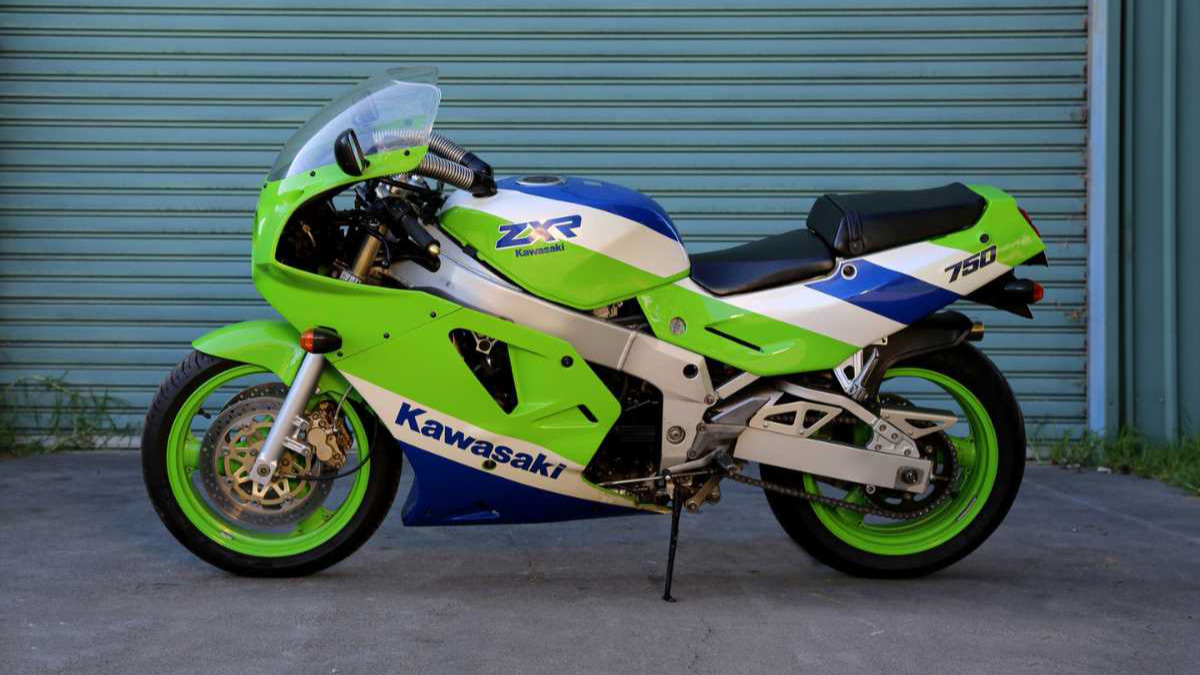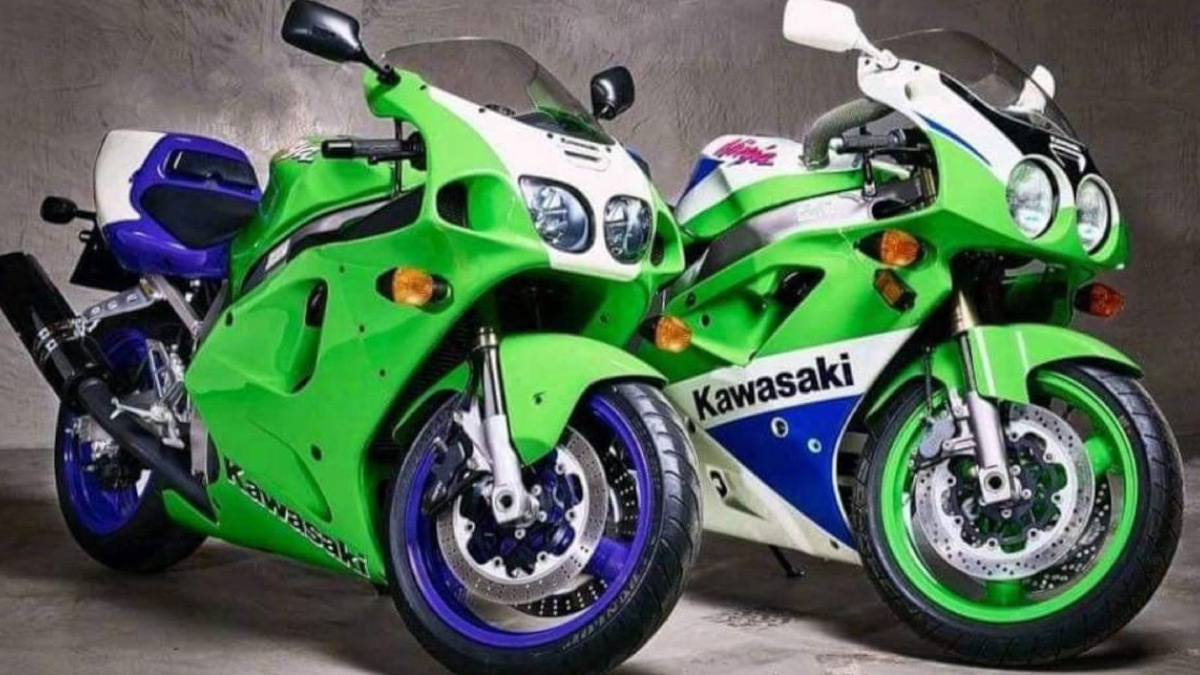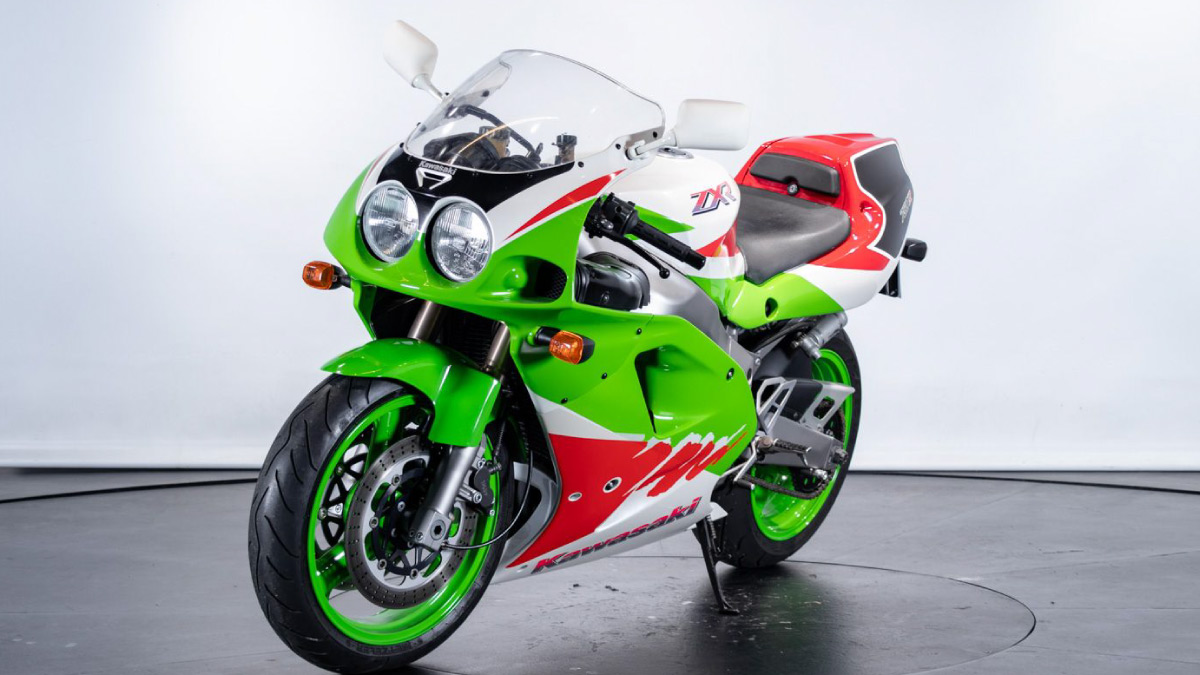THRYLLZ
Thrills we thrive on
Thrills we thrive on
The next Classic Crush in our spotlight is the Kawasaki ZXR-750. And with it, the ZXR750R. Of course, we cannot forget this fourth Japanese brand and their famous mid-range sports bike. It is a direct competitor to the Honda RC30, the Yamaha OW01 and the Suzuki Slabby.
Some time ago, we set our sights on a 1996 ZX-7R. In the end, we didn’t buy it. Our wallet stopped us. The less rare versions are not that expensive, but we still prioritised other things. Nevertheless, we still have a huge weakness for the rounded cheeks and mischievous “fox eyes” of the 1996 model.
The original Kawasaki ZXR-7 was introduced in 1988. From 1989 to 1995, Kawasaki called the model “ZX7 Ninja” in the United States and ZXR-750 in Europe and the rest of the world. Because that’s practical, you see? No, neither do we. But anyway, let’s move on! The homologation version is called the Kawasaki ZX7R and the ZXR-750R.
Kawasaki could not afford to be left behind in the 750 cc sports bike hype. So they developed their 750 cc Ninja. The ZXR-750 had a 749 cc inline four-cylinder four-stroke engine. The model rivalled the 750 cc sports bikes from other Japanese brands in terms of popularity. But in reality, the ZXR-750 was no match for competitors such as the Suzuki GSX-R 750. The Kawasaki was simply too heavy compared to its rivals. However, its handling was quite good, the bike felt stable on the road and looked damn good. And with that, the model gained a large following of fans.
Engine: 749 cc transverse 4-cylinder four-stroke
Power: 105.3 hp @ 10,500 rpm
Seat height: 770 mm / 30.3 inches
Fuel system: Carburettors
Dry weight: 205 kg / 451.9 lbs
Top speed: 245.5 km/h / 152.5 mph

In 1989, Kawasaki introduced the ZXR H1, which was called the ZX7 in the US. The H1 resembled the first model of the ZXR-7. The engine had 105 hp and a dry weight of 205 kilograms. Not bad figures for that time. If you line up all the models and versions of the ZXR-750, the H1 stands out thanks to its iconic round twin headlights. Something you see in many well-known sports bikes from the 1980s.
The H1 was followed by the H2 in 1990. Although the H2 looked very similar to the H1 in terms of appearance, both the engine and the frame underwent quite a few changes. As a result, many parts from the H1 do not fit the H2 and vice versa. This made and still makes it difficult to find spare parts. The H2 had 107 hp and a dry weight of 200 kilograms.
In 1991, the ZXR-750 was updated. The ZXR J1 and J2 were introduced between 1991 and 1992. Interesting fact: Kawasaki limited the J models to 100 hp. Normally, it is not that difficult to remove such a limitation, but with these two models it seems almost impossible. Unique, interesting and strange at the same time.
The J models were the first ZXR versions with upside-down suspension. They were also slightly lighter than their predecessors, weighing around 195 kilograms.
The racing versions of the J models were given the letter K. There were the K1 and the K2. These were the homologation superbike specials and were produced in limited numbers. They had the same frame as the J models, but were fitted with an unrestricted engine. This gave you a very respectable 121 hp under your bum, with a dry weight of 190 kg. They also had Flat Side carburettors, a close-ratio gearbox with closely spaced gears and fully adjustable suspension.
The ZXR-750 L models were launched between 1993 and 1995. The L models were the first to feature Ram-air. They had a single air intake on the left side of the headlights. This type was equipped with the engine from the K racing models and delivered a respectable 119 hp and had a dry weight of 205 kg.
Homologation models were also produced during these years of manufacture. These were given the letter M. There is the ZXR-R M1 from 1993 and the ZXR-R M2 from 1994. Do you remember what we said in previous articles in the Classic Crush series about that “R”? The more ‘R’s in the name, the faster the motorbike. There is absolutely no scientific evidence to support this statement. But that’s just how it works in the racing world. The ZXR-R M1 and M2 had 121 hp and a dry weight of 200 kg.
In 1996, Kawasaki dropped the ZXR name and standardised the name for all countries. The ZX-7R designation continued until 2003. These models were given the letter P. This resulted in the P1 in 1996 through to the P7 in 2003. The new ZX-7R had a shorter stroke and wider bore. This gave the motorcycle more midrange power. The P model can be recognised by its double air intake (one on each side of the headlights), the “fox eyes” and the adjustable suspension.
Once again, Kawasaki came up with a homologation model to compete in the Superbike World Championship. This model became the Kawasaki ZX-7RR.

The 1996 Kawasaki ZX-7R may be heavy compared to its fast rivals, but the bike stands out thanks to the precision at the front. If you want, you can place the bike anywhere in a corner. The front gives a lot of feedback, especially for a motorbike of its age. You know exactly where the front is going. It’s not the easiest bike to steer straight from the factory. But that’s easily solved by raising the rear slightly. And by fitting tyres with a slightly sharper profile.
In terms of engine, the Kawasaki ZX-7R did not set a new standard. But even today, it is still a great engine. And with 110 hp on the rear wheel, it is still a pretty fast bike. That was very respectable, especially at the time. Keep in mind that motorcycle clothing with airbags was certainly not standard back then.
In 1996, the Kawasaki ZX-7R still had carburettors. Some people jump for joy when they hear that, while others are not so happy about it. An engine with carburettors has a certain magic about it. But if you’re not familiar with it, the engine can be a bit of a mystery to you.
Simply put, it means that the engine runs very smoothly if everything is in good condition and has been maintained with some care. It stalls as soon as it gets cold and damp outside and the engine “freezes” a bit. And it can cause complicated problems once the engine reaches a high mileage. To some, that sounds like a nightmare. To others, it sounds like an adventure.
The Kawasaki does not excel in terms of quality. After quite a few years, the suspension wears out faster than you would like. The pipes rust and the paint peels off the wheels and brake calipers. But it wasn’t made to just look good. It was made to be ridden. And to be raced. So I guess Kawasaki didn’t make them to last 40 years. Yet many have survived the test of time and you still see them regularly.

Found one you like? Keep in mind that the racing roots of the Kawasaki ZX-7R are very much present. It does what it’s supposed to do: ride fast. The ZX-7RR may have been less successful than the Honda RC30, but this green monster still offers a lot of fun on track days. The riding position is racy. That means head down, bum up. And you have to squeeze that derrière onto a thin layer of material, often referred to as “the seat” or saddle. Some find the ZX-7R comfortable, but most do not.
The levers for a passenger on the back of the motorbike may look inviting. But don’t be fooled. There is little room for the passenger to fold their legs.
One thing the Kawasaki excels at is mediocrity. Everything was just not as good as it could have been. The ZX-7R could have been better built. With higher quality. The gauges on the dashboard could have been less crowded. The mirrors could have provided more visibility. The headlights could have worked better. Been brighter. But hey, they do look good and give the motorbike a cute look.
The ZXR-750 isn’t that overwhelming. And that’s exactly why I think it’s fantastic. It proudly stands among our Classic Crushes. The Yamaha OW01 may be a better racing bike in general, but it has one thing in common with the ZX-7R: its looks. Both the Yamaha and the Kawasaki kindly demand your attention while the bike stands modestly in the corner of the room. Or in the garage. Put a room full of motorcycles and they immediately stand out. That’s how good they look.
Do you buy a motorbike purely for its looks? Probably not. Not always, at least. Not if you’re looking for a motorbike that you actually want to ride regularly. But if you don’t mind giving the motorbike the attention it so kindly asks for, and maybe a little extra because you simply love it so much… then the ZX-7R is the perfect motorbike. The Kawasaki shows that a motorbike doesn’t always have to be the lightest or fastest or have the latest technology to be incredibly popular.
We use cookies to improve your experience on our site. By using our site, you consent to cookies.
Websites store cookies to enhance functionality and personalise your experience. You can manage your preferences, but blocking some cookies may impact site performance and services.
Essential cookies enable basic functions and are necessary for the proper function of the website.